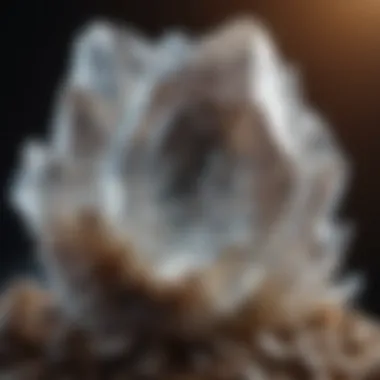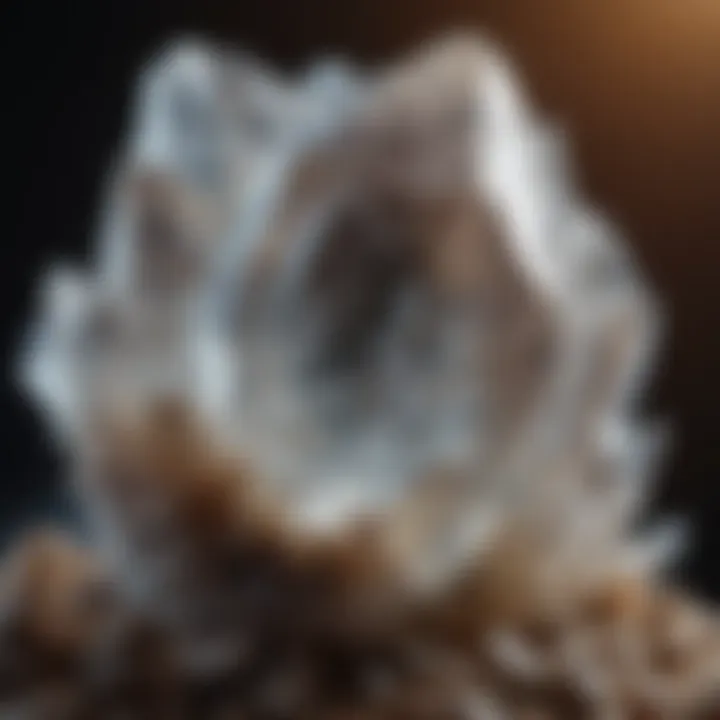Exploring the Connection Between EMF and Raw Crystals


Intro
Electromagnetic fields (EMF) are a constant presence in our world, connecting us to a web of unseen energies. With the rise of technology, our environments are saturated with these waves, creating a unique interplay between nature and modernity. At the same time, raw crystals have captivated human interest for centuries. The assumption that these natural formations might have the power to influence EMF presents intriguing possibilities for both collectors and enthusiasts alike. Here, we’ll embark on a journey that intertwines science, metaphysics, and the tangible beauty of raw crystals.
Featured Collectible of the Month
Overview
In the realm of raw crystals, amethyst stands as a shining example. Its deep purple hues are not only visually stunning but also steeped in a rich cultural history. This crystal is often associated with spirituality and intuition, frequently utilized by practitioners in various metaphysical practices.
Historical Significance
Amethyst has been cherished throughout human history. The ancient Egyptians used it in burial rituals, believing it provided protection and guidance in the afterlife. The Greeks referred to it as a safeguard against intoxication, hence its name derived from the word "amethystos," meaning "not drunk." This crystal has transcended time, popular in royal insignia and jewelry. Today, it finds its place in both healing practices and as an exquisite collectible.
Amethyst's rich past and compelling lore makes it a must-have for any serious collector, blending beauty with historical weight.
Identification Techniques
Visual Characteristics
Identifying amethyst is relatively straightforward, thanks to its distinctive features:
- Color: The color ranges from light lavender to deep violet. Typically, the deeper the hue, the more valuable the stone.
- Clarity: High-quality amethyst typically possesses few inclusions. A good piece shows a clear purple color without too many surface imperfections.
- Shape: Crystals often form in a natural point, though it can also appear in clusters or geodes.
Resources for Identification
For those seeking to deepen their understanding of raw crystals like amethyst, various resources exist:
- Wikipedia offers a foundational overview of crystal properties and uses. Visit Wikipedia for more.
- Britannica presents scholarly articles on the historical significance of crystals. Check out their entries on gemology at Britannica.
- Reddit hosts many forums where collectors share tips, tricks, and advice on identifying and valuing crystals. Explore these discussions at Reddit.
- Facebook groups focused on crystal collecting can provide community insights and shared knowledge among enthusiasts. Connect with like-minded individuals at Facebook.
With this knowledge, rock and fossil collectors can navigate the fascinating world of raw crystals and their interaction with EMF. The continuous discourse in both scientific and metaphysical circles enhances our understanding, offering multiple perspectives on these remarkable natural treasures.
Preamble to EMF and Raw Crystals
In the contemporary world, the significance of understanding the interplay between electromagnetic fields (EMF) and raw crystals comes into sharp focus. As technology surges forward, we find ourselves increasingly surrounded by artificial EMF emanating from the gadgets we use daily. This omnipresence of electromagnetic energy raises vital questions about its effects on human health and the environment. At the same time, raw crystals, often revered in both scientific and metaphysical circles, present themselves as potential agents for mitigating some of these impacts.
The exploration of this topic encompasses not just the physical properties of EMF and raw crystals but also the broader implications they hold for well-being, environment, and even culture. Knowledge in this area can empower individuals to make informed decisions about integrating crystals into their lives, either as a form of protection against EMF or as tools for enhancing one’s energy.
Definition of EMF
Electromagnetic fields are the invisible forces around us created by the movement of electrically charged particles. To break it down, EMF can be viewed as comprising both electric fields, which arise from voltage differences, and magnetic fields, which are linked to currents flowing through wires. These fields are quantified in hertz (Hz), representing how often the field oscillates. Natural sources include the Earth’s magnetic field and sunlight, while artificial sources consist of everyday technologies, such as mobile phones, microwaves, and Wi-Fi routers.
The health implications stemming from prolonged exposure to artificial EMF are under continuous study, as discussions range from complete acceptance of all electromagnetic exposure to more cautious perspectives calling for better regulation and guidelines. The complexity of EMF requires careful examination to discern its influence on human physiology.
Understanding Raw Crystals
Raw crystals are naturally occurring solid substances made up of atoms arranged in an ordered structure, commonly celebrated for their beauty and uniqueness. The formation of these crystalline structures happens over geological timeframes, often requiring thousands of years, through various processes including cooling of magma, evaporation of water, or within metamorphic environments.
Crystals come in a vast array of types, colors, and compositions, each believed to possess distinct properties. For instance, quartz, often considered the most versatile crystal, is said to amplify energy and intention. In contrast, amethyst is touted for its calming effects, while tourmaline is frequently highlighted for its potential EMF shielding abilities. Collectors and enthusiasts alike find fascination not only in their aesthetic qualities but also in the tangible and intangible benefits they may offer.
This section serves as the groundwork for understanding the relationship between raw crystals and EMF, setting the stage for a comprehensive exploration that will bridge scientific perspectives with more traditional beliefs. As we delve deeper, we will uncover the rich lore that surrounds these stones while acknowledging the scientific scrutiny that accompanies such discussions.
The Science of Electromagnetic Fields
Understanding electromagnetic fields (EMF) is vital in our exploration of raw crystals. EMF is all around us, generated by both natural and artificial sources. This section will break down the types of EMF, their measurement, and the implications they have when it comes to crystals and their purported benefits. Knowing how these fields operate can help us assess the role crystals might play in mitigating or enhancing electromagnetic interactions.
Types of EMF
Natural EMF
Natural EMF originates from phenomena like lightning, the Earth’s magnetic field, and cosmic radiation.
- Key Characteristic: One of the standout features of natural EMF is its fundamental link to the Earth's natural processes. It's as if this type of EMF has been part of our planet since time immemorial.
- Contribution to the Topic: In this article’s context, natural EMF signifies a backdrop against which the interactions of raw crystals with electromagnetic forces can be observed. The tranquility of nature’s electromagnetic environment is believed by some to resonate well with the properties of certain crystals, creating harmony.
- Unique Features: The distinctiveness of natural EMF lies in its stability. It reflects a consistent, rhythmic energy signature that can potentially complement the vibrational qualities of raw crystals, enhancing their effects on well-being.
- Advantages/Disadvantages:
- Advantages: This stratum of EMF is often seen as positive, as it supports life and contributes to a balanced ecosystem. Many believe it offers protective qualities that could be boosted by the right crystals.
- Disadvantages: Natural EMF can still be subject to fluctuations during solar events or weather changes, which may affect crystals' perceived ability to work in sync with this energy.
Artificial EMF
Artificial EMF, on the other hand, emanates from human-made sources like electrical appliances, radio waves, and mobile devices.
- Key Characteristic: A defining feature of artificial EMF is its erratic nature. Unlike its natural counterpart, artificial EMF can vary considerably in intensity and frequency, creating a dynamic, sometimes chaotic environment.
- Contribution to the Topic: This type of EMF presents a challenge and opportunity when discussing raw crystals. Many proponents argue that these crystals could play a role in counteracting the potential adverse effects of man-made electromagnetic exposure.
- Unique Features: Artificial EMF often operates in higher frequencies compared to natural EMF. This could lead to increased anxiety or stress among living beings, and it's this kind of stress that many suggest crystals can help alleviate.
- Advantages/Disadvantages:
- Advantages: Proponents often cite the potential for crystals to shield or reduce the harsh impacts of high-frequency artificial EMF. They see these stones as a means for grounding amid today's digital barrage.
- Disadvantages: Skeptics argue that the lack of scientific evidence regarding effectiveness leads to uncertainty—questioning whether crystals truly provide a remedy or are simply a comfort in a high-tech world.
Measuring EMF


Common Instruments
To truly grasp EMF’s role in our environment and its relation to raw crystals, accurate measurement is necessary. These instruments allow us to quantify electromagnetic frequencies.
- Key Characteristic: Common instruments such as EMF meters (e.g., TriField 100XE or Cornet ED88T) exhibit the ability to measure both natural and artificial EMF.
- Contribution to the Topic: Applying these devices can give crystal enthusiasts a tangible method to identify levels of EMF present in their settings, thus providing context for discussions surrounding the use of crystals.
- Unique Features: These meters often feature various settings to detect different types of EMF, which allows users to tailor their readings based on specific environments such as home or office.
- Advantages/Disadvantages:
- Advantages: They can be quite reliable, offering real-time data that can lend credence to observations regarding crystals’ effects.
- Disadvantages: However, they can also be costly; some users may find themselves overwhelmed by the available options and features.
Understanding Measurement Units
EMF measurements are expressed in various units, such as volts per meter (V/m) and microsieverts (µSv), depending on what is being measured.
- Key Characteristic: The diversity of units can create confusion, but understanding them is crucial for any serious assessment of EMF.
- Contribution to the Topic: By delving into these units, readers can better interpret readings from measuring devices, allowing for informed discussions on how these relate to raw crystals.
- Unique Features: Each measurement unit serves its purpose within context; volts per meter often pertains to electric fields, while microsieverts relate to radiation exposure.
- Advantages/Disadvantages:
- Advantages: Knowledge of these units can enhance one’s understanding, empowering individuals to take proactive steps in their crystal practices.
- Disadvantages: On the flip side, jargon-heavy science could alienate those less familiar, causing a gap in communication in the broader conversation about EMF and crystals.
Raw Crystals: An Overview
The world of raw crystals is vast and captivating, holding a significant place in both the scientific and metaphysical realms. Understanding raw crystals is crucial in the exploration of their role in relation to electromagnetic fields. The natural properties of these crystals contribute to their potential benefits, including energy amplification and EMF shielding, which are commonly cited in various practices. This section is centered on the formation, types, and significance of raw crystals, delving into what makes these geological wonders unique and valuable.
Formation of Raw Crystals
Geological Processes
The formation of raw crystals is intimately tied to geological processes, which provide the essential conditions for crystal growth. Crystals are typically formed in several environments, ranging from volcanic eruptions to sedimentary layers. One key characteristic of these processes is their diverse nature; for instance, igneous rocks can create crystals through the cooling of molten rock, while metamorphic environments can shape existing minerals into new forms. This aspect is integral to the article as it establishes the foundational knowledge about how crystals originate from the Earth's materials.
Understanding geological processes is a beneficial choice because they help illustrate the immense time and pressure conditions that lead to crystal formation. A unique feature of these processes is their lengthy timeframe. Often, some crystals take millions of years to form, which adds to their mystique and appeal among collectors and enthusiasts. However, it can also be a disadvantage when considering the accessibility of certain crystals, as not all geological formations are easily reached or found.
Timeframe for Growth
The timeframe for crystal growth further enriches our understanding. Crystals develop when the right conditions persist over extended periods. The timeline can vary widely: some simpler structures can form in mere months, while more complex ones may take thousands or millions of years. This aspect highlights the longevity and resilience of crystals, crucial for both their aesthetic and their purported energetic properties.
This characteristic of prolonged growth also serves as a beneficial aspect for the article, emphasizing the idea that the more time a crystal has to develop, the more unique its structure may become. For instance, variations in color and inclusions often stem from the lengthy growth processes where external factors influence the mineral's characteristics. However, the unique feature of such long growth periods can also mean that sourcing certain raw crystals can be challenging, creating barriers for both collectors and users who wish to harness their potential benefits.
Types of Raw Crystals
Quartz
Quartz is one of the most prevalent types of raw crystals found on Earth, and its significance in this discussion cannot be understated. As one of the most abundant minerals in the Earth's crust, quartz exemplifies both beauty and utility. The key characteristic of quartz lies in its piezoelectric properties, which allow it to generate an electric charge under mechanical stress. This property makes quartz engaging for those studying EMF, as it serves as a medium through which electromagnetic energy may be manipulated.
Moreover, the unique feature of quartz is its remarkable versatility. It appears in countless forms—clear quartz, rose quartz, and smoky quartz, each holding different energetic properties purported in various traditions. This is advantageous for practitioners in metaphysical communities who utilize these variations for specific intentions. However, the abundance of quartz also makes it somewhat less unique than other crystal types, potentially leading to a lack of reverence among collectors.
Amethyst
Amethyst stands out due to its striking purple hue and its historical significance. Known for its calming properties, amethyst is often associated with spiritual growth and transformation. The key characteristic of amethyst is its connection to stress relief and emotional balance, making it popular among enthusiasts eager to use crystals for self-care practices.
Amethyst's unique feature is the trace elements of iron that give it that distinctive purple coloration. This aspect is what draws many to seek it out for both aesthetic and practical uses. Additionally, its relatively wide availability allows for numerous applications in modern wellness practices, although depending on its source, quality can vary greatly, lending it some disadvantages if one is seeking the highest grade pieces.
Tourmaline
Tourmaline is remarkable for its complex structure and variety of colors, each linked to different elemental compositions. The type of tourmaline most relevant in EMF discussions is black tourmaline, celebrated for its protective properties against electromagnetic radiation. This mineral's ability to absorb negative energy is a significant point of interest for many.
The key characteristic of tourmaline that enhances its appeal is its thermoelectric and pyroelectric properties, enabling it to convert temperature and pressure changes into electrical currents. This unique feature is particularly beneficial as collectors and users may find it practical for their EMF-related needs. However, tourmaline can be harder to source in its raw form, leading some to resort to less reliable, processed alternatives, which could be viewed as a disadvantage.
In summary, this overview of raw crystals reveals not just their geological origins but also their diverse types and properties. Such understanding deepens the conversation around their interaction with electromagnetic fields, enriching the discourse for both collectors and practitioners alike.
Perceived Benefits of Raw Crystals
The discussion surrounding the perceived benefits of raw crystals is ever-evolving and significant in the context of electromagnetic fields (EMF) interactions. Many enthusiasts and practitioners cite claims on how certain crystals can enhance energy and well-being when used in conjunction with everyday technology. The importance of this topic lies not only in the belief systems surrounding the crystals but also in how it intersects with scientific exploration and user experiences. This section will investigate various claims, emphasizing the effects of raw crystals on EMF, as well as their influences on physical and emotional health.
Influence on EMF
Energy Amplification
Energy amplification is frequently touted by proponents as a vital benefit of specific raw crystals. This aspect suggests that certain crystals can enhance or boost energy levels, whether that energy is derived from the environment or within one's self. The key characteristic to note here is the idea that crystals possess unique structures that allow them to transmit and amplify energy fields.
Many users believe that holding or placing these crystals in their immediate environment can lead to an invigorating effect. For instance, clear quartz is often highlighted for its reputed ability to serve as a powerful amplifier of energy. Some claim that this amplification makes it a rather popular choice among communicators and people engaged in creative endeavors.
However, while these claims are compelling, they come with their own collection of unique features and challenges. Not all individuals will feel the effects in the same manner, which leads to variability in personal experiences. As energizing as these crystals can be for some, they might not yield the same results for everyone.
Shielding Properties
Another significant aspect is shielding properties. Certain raw crystals are believed to form a protective barrier against harmful EMF. This shield serves as a source of comfort for those who are increasingly aware of the potential risks associated with prolonged exposure to artificial EMF generated from electronic devices. For example, black tourmaline is frequently cited among enthusiasts for its purported abilities to absorb and transmute negative energies of various kinds, including electromagnetic pollution.
The appeal of these shielding properties lies in their potential to foster a sense of protection within the home or workspace. Individuals often prefer crystals that can safeguard them from unseen threats, allowing them a respite from the outside world's digital noise. However, it's worth acknowledging that while many find these properties appealing, there lacks empirical evidence rigorously demonstrating these claims.


Physical and Emotional Wellbeing
The benefits of raw crystals extend into the realm of physical and emotional wellbeing, where they are often lauded for their positive impacts on stress levels and concentration.
Stress Reduction
Stress reduction is a popular claim made regarding the use of crystals, particularly in high-pressure environments. Many users report feeling calmer and more centered when surrounded by specific stones, such as amethyst or rose quartz. The key characteristic here is their reputed ability to mitigate anxiety and promote tranquility.
Biblical references and older yet timeless traditions sometimes lend credence to the idea that crystals can balance energy and provide emotional relief. Those who use them often value these qualities because they facilitate mindfulness and an opportunity to unwind in hectic surroundings. However, while personal testimonies abound, there remains a clear lack of scientific validation in many instances.
Improving Focus
Improving focus is another prevalent claim among those incorporating crystals into their daily routines. Certain stones, such as citrine, are said to enhance clarity and boost mental acuity. This quality often draws interest from students and professional groups aiming for higher productivity.
The unique feature of focus-enhancing stones generally relates to their capacity to promote mental clarity, which can help individuals remain on track with tasks. Yet, again, while many endorse these stones as beneficial, subjective experiences differ from person to person, and scientific evidence in this arena is sparse.
In summary, while the perceived benefits of raw crystals are multifaceted and widely discussed, they serve to underscore the intertwining nature of personal belief and the quest for understanding in a technology-driven age.
"The journey of working with raw crystals often reflects inward, revealing more about ourselves than about the stones we hold."
Individuals who engage with these stones often strive to discover a balance between their physical surroundings and their emotional states, each benefiting uniquely from their interactions.
Scientific Perspectives on Raw Crystals
Examining the scientific underpinnings of raw crystals provides a nuanced lens through which to interpret their role in relation to electromagnetic fields. This area of inquiry is crucial, not only for discerning the validity of claims made by enthusiasts and practitioners but also for grounding the conversation in empirical research. As technology progresses, the intersection of science and metaphysics concerning raw crystals becomes a compelling dialogue since it incorporates both traditional beliefs and contemporary scientific methods.
Current Research
Studies on EMF Interaction
Research regarding the interaction of EMF and raw crystals is in an evolutionary phase. There are various studies, and one fundamental characteristic is the focus on energy fluctuations that these crystals may influence. For example, some investigations have sought to measure the altering properties of quartz crystals when subjected to different EMF frequencies. The primary advantage here is that it allows for an empirical framework through which the crystals' purported effects can be scrutinized. However, the findings can often lean towards the speculative, making them a double-edged sword in the discourse.
A unique feature of these studies is that they often involve specialized equipment, such as oscilloscopes, to visualize interactions. Yet, this reliance on high-tech tools can introduce complexities. In essence, while the ambition is commendable, the results frequently invite skepticism. The variance in individual responses to EMF presented at a base level complicates universal conclusions, thereby leaving much to be desired in terms of coherence in the scientific narrative.
Crystallography Insights
Crystallography plays a pivotal role in understanding the structure and function of raw crystals. This aspect is particularly appealing as it delves deeply into crystal lattice arrangements and their getting impacted by electromagnetic forces. One key characteristic of crystallography is its revealing nature concerning how atoms arrange themselves in a crystal and how this impacts their properties, including conductivity and vibrational resonance.
What makes crystallography particularly relevant to this discussion is the way it resonates with assertions regarding certain crystals—like amethyst—potentially providing grounding or stability against electromagnetic pollution. The unique feature here is that crystallography can enable researchers to generate models for how crystals might react to different frequencies. However, it can be somewhat esoteric and, therefore, not always readily accessible for the casual reader. This obscurity leads to a certain advantage and disadvantage: while thoroughly grounding assertions in scientific analysis, it simultaneously distances the everyday user from the intricate mechanics behind these claims.
Skepticism and Criticism
Moving on, it’s vital to engage with the skepticism surrounding raw crystals from a scientific standpoint. Counterarguments often arise concerning both methodology and anecdotal evidence provided by proponents.
Challenges to Methodology
One notable challenge often mentioned pertains to the methodologies employed in experiments involving raw crystals and EMF. Many studies fall short in terms of reproducibility and consistency, leading to questions about their reliability. The key characteristic of this challenge is its significant implications for the credibility of findings. If methodologies are not robust enough, the findings become easily questioned, resulting in a series of detractions from their potential validity.
The attraction of these methodologies lies in their promise for extensive exploration in a minimally explored field. However, many researchers find themselves needing to navigate through biases, both self-adopted and those prevalent in popular beliefs surrounding crystals. This raises the bar on rigor in experimental design, and it's clear that more robust schemas are needed to bridge the gap between meta-claims and scientific merit.
Questioning Anecdotal Evidence
Anecdotal evidence often serves as the backbone for many claims supporting the use of raw crystals. People recount personal experiences that suggest various benefits or protective qualities, especially concerning EMF exposure. The challenge, however, is integrating these personal accounts into a scientifically rigorous framework. The core characteristic of this skepticism is the fundamental question of reproducibility—an essential tenet of the scientific method.
By relying solely on anecdotal evidence, there exists a risk of promoting subjective experiences over objective reality. Nonetheless, such evidence can provide valuable leads for more thorough exploration. The unique element is that, while personal stories carry weight, they often sit contrary to empirical data, leading to a dichotomy in understanding the role of crystals in EMF interactions. Nonetheless, the potential for future research can find a solid footing by marrying anecdotal insights with the rigor that scientific studies demand.
"In the realm of science, subjective experience doesn't negate empirical evidence; it merely adds a layer that needs to be explored."
In summary, the scientific perspectives on raw crystals present a rich tapestry of inquiry, often oscillating between robust scientific exploration and the nebulous realm of anecdotal supports. By acknowledging both avenues, the conversation becomes not just about what crystals can do against EMF but also about the legitimacy of the methods and stories that fuel the dialogue.
Practical Applications of Raw Crystals in Today’s World
Raw crystals have made their mark in contemporary society, not just as aesthetic enhancements but as tools believed to influence well-being and interaction with electromagnetic fields (EMF). Understanding their practical applications allows individuals, especially rock and fossil collectors, to appreciate their potential benefits and the various contexts in which they might be used. This section delves into how raw crystals can serve a dual purpose in our homes and wellness practices, creating a holistic approach to life amidst the EMF prevalent in our surroundings.
In Home Environments
EMF Protection
One prominent use of raw crystals is for EMF protection. With the rise of technological devices emitting varying degrees of electromagnetic radiation, people are increasingly concerned about the potential health risks. Crystals like black tourmaline are often touted for their ability to absorb and deflect harmful energies, aiding in reducing the stress these fields may impart on our bodies.
The key characteristic of using crystals for EMF protection lies in their purported energetic properties. Many believe that these stones can act as natural shields, reducing the impact of EMF exposure. This aspect has garnered attention due to the growing dialogue around environmental health.
However, it's essential to remember that the efficacy of crystals in this regard remains widely contested, with much of the support based more on anecdotal evidence rather than concrete scientific backing. Still, their use offers a physical manifestation of protection, instilling a sense of control over one's environment.
Decorative Uses


Another practical aspect of raw crystals in home settings is their decorative appeal. Beyond their aesthetic beauty, they also add a personal touch to living spaces. Whether displayed on a shelf or incorporated into home decor, crystals can create an inviting ambiance.
The vibrant colors and unique formations certainly attract attention. Crystals such as amethyst and clear quartz not only enhance decor but also invite conversation, lending a personal narrative to the spaces they occupy. This characteristic makes them particularly appealing to rock aficionados, who appreciate both science and craftsmanship.
However, while their visual benefits are clear, some individuals may be skeptical about their claimed energetic properties in enhancing the home's environment. Ultimately, the decision to include them decoratively ties back to individual belief systems and the intention behind the use of such stones.
In Wellness Practices
Crystal Healing
In the realm of wellness, crystal healing is prominent. Practitioners use specific crystals believed to aid in physical and emotional health. For instance, rose quartz is coveted for its reputed ability to foster love and compassion. This aspect serves as a critical bridge between the physical properties of the stones and their alleged metaphysical benefits.
Believers argue that through their unique vibrational frequencies, crystals can interact with the body's energy fields, promoting healing and balance. This perspective presents crystal healing as an integral component of holistic wellness, appealing to those searching for alternative remedies in a fast-paced world.
The downside, however, lies in the skepticism surrounding this practice. Many critics argue that the effects are related to placebo rather than intrinsic properties of the crystals themselves. Still, the emotional comfort that comes from these beliefs provides significant support to practitioners, making it a valuable aspect of wellness practices for many.
Meditation Aids
Lastly, raw crystals have gained popularity as meditation aids. Practitioners often use specific crystals to deepen the meditative experience, believing they facilitate concentration and spiritual connection. Crystals like selenite are often favored for their clarity and tranquility.
This characteristic has rendered them as beneficial allies in achieving mindfulness and deeper states of relaxation during meditation. Those who engage in regular practices note that having a crystal nearby can enhance their focus and peace during sessions.
Nevertheless, some might argue that the benefits arise not from the crystals themselves but from the act of incorporating a tangible object into a meditative routine. This highlights an interesting phenomenon in mindfulness, where personal meaning and ritual can drive perceived effectiveness.
"The crystal does not hold power; we give it meaning and intention, shaping our experience in the moment."
Ethical Considerations of Raw Crystal Use
In the journey of examining the intricate relationship between electromagnetic fields and raw crystals, it's crucial to address the ethical considerations tied to their use. As the popularity of raw crystals has surged in recent years, particularly within holistic and wellness circles, the practices surrounding their sourcing and application have come under scrutiny. This section explores sustainable practices in crystal collection and the cultural implications that accompany their use, providing a holistic view of their ethical dimensions.
Sustainability and Sourcing
Sustainability in sourcing raw crystals is paramount for both environmental health and the communities involved in their extraction. The mining of minerals and crystals often leads to significant ecological disruption, including habitat destruction and pollution. Therefore, it becomes essential for enthusiasts and collectors alike to inquire about the origins of their crystals. Many suppliers now emphasize ethical sourcing practices, which often means they obtain materials from mines that prioritize environmental care and community well-being.
Here are some key aspects to consider regarding sustainability:
- Responsible Extraction: Look for crystals mined using methods that minimize environmental harm.
- Transparent Supply Chains: Seek vendors that can trace their crystals back to the original source, ensuring no harmful practices were utilized in their extraction.
- Supporting Local Communities: Purchasing from local and artisanal miners can contribute to the economic sustainability of communities rather than large, profit-driven corporations.
A focus on these practices not only supports the planet but also fosters a more ethical approach toward the hobby of collecting crystals.
Cultural Implications
The use of raw crystals is deeply interwoven with numerous cultures across the globe, each attributing unique properties and significance to these natural wonders. However, as the trend increases in mainstream culture, there are important considerations regarding cultural appropriation and respect for traditions. Crystals are often central to spiritual practices, ceremonies, and even medicinal applications in many indigenous cultures. It is of utmost importance to understand the context behind the practices associated with these stones.
When embracing the use of crystals, one should consider:
- Respect for Indigenous Traditions: Acknowledge and honor the cultural significance that crystals bear for various cultures, and tread lightly when adopting practices that are not your own.
- Avoiding Commercialization: The commercialization of sacred practices can lead to the dilution of cultural meanings and often misrepresentation of those traditions.
- Education and Awareness: Engage in educating oneself about the histories and customs related to the crystals you choose to work with, showing respect and consideration for their origins.
"By understanding the ethical implications related to sustainability and cultural significance, we not only become mindful collectors but also advocates for the dignity and integrity of the communities we touch through our passion for raw crystals."
The End and Future Insights
As we unwrap the layers of information related to electromagnetic fields (EMF) and raw crystals, it's clear that this topic resonates on multiple levels. Not only does it touch upon scientific principles, but it also invites inquiries from metaphysical realms. The concluding section serves as a significant wrap-up that highlights the essence of what we’ve uncovered thus far. We’ve explored various facets—ranging from the formation and types of crystals to their perceived benefits and the skepticism surrounding their efficacy.
This mingling of traditional beliefs and contemporary scientific scrutiny enhances our understanding. The narratives have interlaced to form a tapestry that informs rock and fossil collectors as well as those interested in holistic practices. By synthesizing these various viewpoints, the reader is left with an enriched perspective.
Summary of Findings
Throughout the article, we delved into numerous aspects of raw crystals and EMF. Key observations include:
- Definition of EMF: We established what electromagnetic fields are and their presence in our environment.
- Raw Crystals Formation: Various geological processes lead to the emergence of different types of crystals, emphasizing their unique origins.
- Perceived Benefits: Focused on how these crystals allegedly interact with EMF, suggesting potential energy amplification and shielding qualities.
- Scientific Perspective: Engaged with ongoing research and skepticism, providing a balanced view on the topic.
By breaking down these findings, we pave the way for further discussion and exploration. With this foundational knowledge, one can approach the subject from a more informed standpoint.
Looking Ahead
Research Directions
In terms of research directions, it is vital to highlight the ongoing studies around the relationship between EMF and raw crystals. This field is still significantly understudied, yet it has garnered attention from both scientists and enthusiasts alike.
- The key characteristic of this research lies in its interdisciplinary nature, incorporating geology, physics, and even psychology.
- This makes it a popular choice as it taps into diverse interests, potentially uniting different communities and fostering collaboration.
However, the unique feature of pursuing these research directions lies in the challenge of quantifying and replicating anecdotal evidence surrounding raw crystals. This presents both advantages in broadening the scope of scientific inquiry and disadvantages due to the inherent subjectivity of personal experiences.
Integrating Traditional and Scientific Views
Bridging traditional beliefs and scientific reasoning creates a synergy that holds substantial benefits for understanding raw crystals’ role in EMF interactions. By integrating these two perspectives, one gains a holistic insight into the subject.
- The key characteristic of this approach is its inclusivity, making way for various beliefs whilst promoting empirical investigations.
- This also emerges as a beneficial choice for our article, offering readers a well-rounded understanding that caters to both skeptics and believers.
Nonetheless, the unique feature of merging traditional and scientific views can create friction, especially among purists in either camp. This can be both advantageous, in pushing the conversation further, and disadvantageous, as clashes may cloud the clarity of the discourse.
By considering these elements, we not only commemorate past knowledge but also lay the groundwork for future discoveries. The convergence of science and spirituality in the realm of EMF and raw crystals invites ongoing exploration. This dialogue will likely enrich the community of rock and fossil collectors, allowing for deeper understandings and new methodologies in both hobbyist and academic pursuits.



